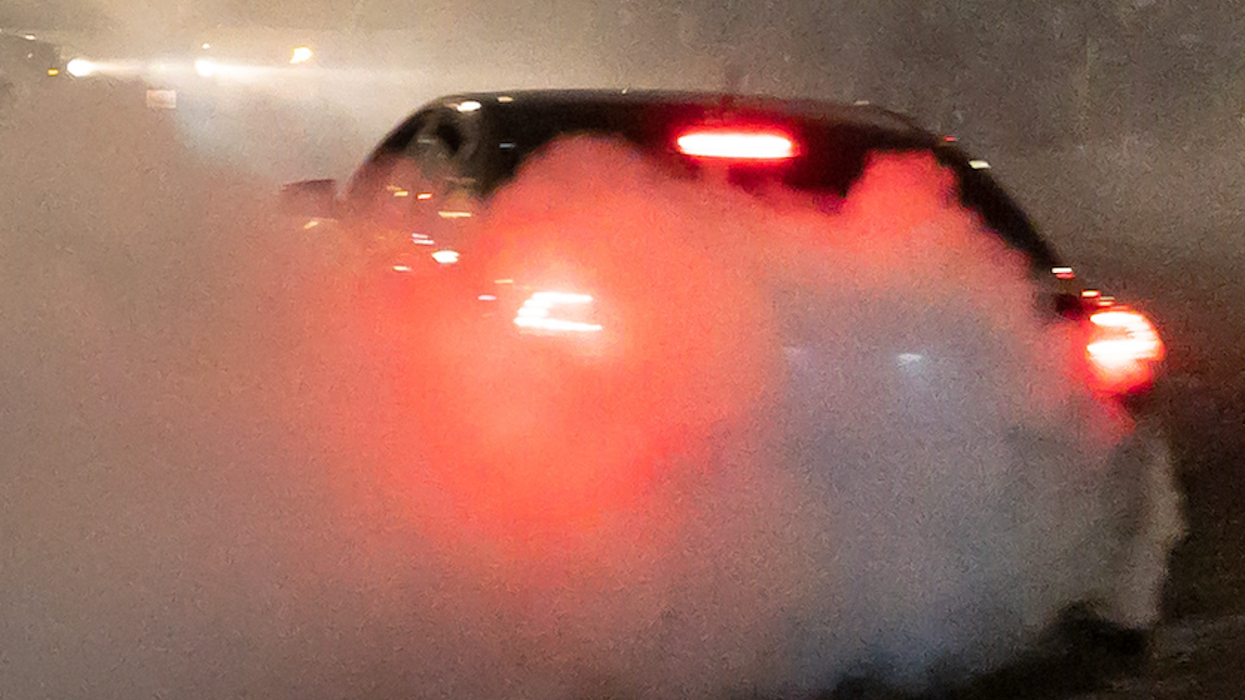
© 2025 Blaze Media LLC. All rights reserved.
Blaze Books featured excerpt: 'Trapped Under the Sea' by Neil Swidey
February 17, 2014
A thought-provoking, at times claustrophobia-inducing, gut-wrenching story of five blue collar underwater construction workers on whose backs a multi-billion dollar multi-year construction project rests. Their lives would never be the same.
Author Neil Swidey is releasing a new book this Tuesday titled "Trapped Under the Sea," a story about how a multi-billion dollar, multi-year, legal and regulatory nightmare of a project to build an almost 10-mile long engineering marvel of a tunnel deep beneath Boston Harbor fell on the shoulders of five blue collar Americans--some of whom never made it back, and others whose lives would never be the same.
Read on for an exclusive excerpt from the book, and be on the lookout for Blaze Books' review and interview with author Neil Swidey tomorrow.

Prologue
JULY 21, 1999
He was about to begin a miles-long trek into the dank, dark intestines of the earth, but DJ Gillis wouldn’t go until he’d found a piece of twine.
Two of the other divers had already packed themselves into the “man cage,” a tubular basket of yellow metal that would be lowered by crane down a 420-foot shaft. But they couldn’t go without DJ, and he wasn’t about to be hurried.
“C’mon, DJ,” one of the guys shouted. “Let’s go!”
DJ ignored the calls as he searched an equipment trailer, sifting through piles of rain gear and crates of tools. The summer sun was beginning its climb above Deer Island, a peninsula that hangs down from the north like a comma into Boston Harbor, curling in front of Logan International Airport.
DJ’s boss, a hard-charging guy by the name of Tap Taylor, was standing near the man cage and losing his patience. “Let’s go!” Tap yelled.
The two of them had a close if combustible relationship. Tap’s singular focus was building his small New Hampshire commercial diving business into something bigger, and he thought nothing of logging fourteen-hour shifts every day of the week. Still, he had a soft spot for DJ, treating the breezy twenty-nine-year-old more like a kid brother than an employee.
Over the years, they had developed a rhythm as predictable as the banter between an anchorwoman and weatherman on the eve of a big storm. DJ, a six-foot-two, solidly built charmer, would show up late to the job site, occasionally dropped off by some blonde or brunette he’d been partying with the night before. As DJ peeled off yesterday’s clothes and put on his dive gear, Tap would curse, threatening to kick him off the job. But those outbursts always ended the same way. Before long, Tap would calm down and begin pumping DJ for details from his latest adventure hopping bars and hopping beds.
“C’mon!” Tap shouted again.
“If you’re in that much of a hurry,” DJ barked, “then go without me!”
It was the morning of July 21, 1999, a Wednesday, and the tension was thick, mainly because so many problems had surfaced on the project that Monday and Tuesday. Getting down the thirty-foot-wide shaft would be the easy part. The challenge would come when the divers had to make their way to the end of a pitch-black tunnel that began at the base of the shaft and kept going and going, under the sea, for nearly ten miles.
Tap would be monitoring the divers’ progress from topside on Deer Island. He was in no mood for DJ’s usual antics. In reality, neither was DJ. The only woman he had on his mind right now was the Virgin Mary. He needed the piece of twine to tie a small religious medal to the underside of his hard hat. The oval medal had once belonged to his grandfather, a carpenter who helped build the Prudential Tower that defined Boston’s skyline.
DJ had asked his mother for it the night before, remembering the story of how his grandfather had kept the Miraculous Medal in his pocket the whole time he spent erecting that skyscraper, taking comfort in the Blessed Virgin’s protection. Seeking comfort himself, DJ had gingerly asked his mom, “Is that still around?”
“Yes,” she had replied cautiously. “Why?”
“I’m a little concerned about the job.”
As much as he had tried to downplay his growing uneasiness with the tunnel project, DJ hadn’t been surprised to see fear flash across his mother’s face. He had just broken one of the cardinal rules he’d learned early on in his career as a commercial diver, when he’d seen oil rigs capsize and cranes collapse: Never tell your family the truth about the dangers of the job. It isn’t fair to dump that kind of worry on them.
But this wasn’t like any job DJ had worked on before. Hell, it wasn’t like any job anyone had worked on before. And that challenge—to make history in his field, to do the seemingly undoable—was what had sold DJ on the tunnel assignment in the first place. With everything that had gone down in the last few days, though, he was feeling some buyer’s remorse.
Finally, he found the twine, fastened the Virgin Mary, and put on his hard hat as he strode over to the man cage.
Tap was still heated. “What the hell were you doing?” he snapped. “We’ve got a job to do here.”
DJ took off his hat and turned it over, so his boss could see the medal dangling from it. “I’m taking care of myself,” he said.
Tap’s steam instantly lifted. “It’s getting that bad, huh?”
The man cage spun slowly as it moved down the shaft, like a gentle whirlpool of water circling around a drain. DJ was a talker, but now he felt no urge to speak. He stared across the cage at the other two divers, guys he’d known for only a couple of weeks. He had an especially tough time getting a bead on the shorter of the two, Dave Riggs. While divers tended to be a rowdy bunch, pounding beers and swapping stories after their shift, Riggs didn’t drink and kept to himself. During one of their first days working together, DJ had been doing what he always did—telling lots of tales, peppered with colorful words—when Riggs turned to him and said, “I’d appreciate it if you didn’t use foul language within my earshot.” DJ narrowed his eyes as he stared back at Riggs in disbelief. Then he said the first thing that came into his head: “Are you f***ing kidding me?” He’d been a diver for seven years, and he’d never once come across anyone who confused a job site with a church pew.
He had a better connection with the other guy in the cage, Donald Hosford, known as Hoss to everyone except his mother. Hoss had a ropy, six-foot-five build and the rugged looks of someone who might appear in a magazine ad for the Copenhagen chew he always kept wadded under his lip. He was only twenty-four years old, but he worked with the confidence and sure movements of a seasoned veteran. To DJ, Hoss embodied the cowboy spirit of the experienced divers he’d always looked up to: take-charge guys who could be rough and even crude on the job, but who always addressed a lady as “ma’am” and reflexively pulled out a chair for her. Still, DJ thought to himself, the guy seemed so steely that, if need be, he could put a bullet in another man’s forehead and then go right back to eating his supper.
As the man cage neared the bottom, DJ fixed his eyes on a fat ventilation duct that transported air from Deer Island, down the shaft, and into the tunnel. For years, a “bag line” had run all nine and a half miles of the tunnel, providing plenty of ambient air to the subterranean workers known as sandhogs, who were responsible for burrowing down under. Now the duct ended right where the shaft did, at the very start of the tunnel.
DJ had heard that the sandhogs had spent nearly a decade mining the tunnel—twice as long as planned—and that the contractor was tens of millions of dollars in the red. The fact that he and the other divers were being called in during the final hour was itself evidence that something had gone seriously wrong. After all, the divers were being asked to finish the job even though the ventilation, electricity, and transportation systems—the infrastructure that had kept the sandhogs alive—had already been removed from the tunnel.
DJ couldn’t tell if the project’s bosses viewed his crew as their cavalry or as the equivalent of a Hail Mary pass. The few sandhogs still hanging around on Deer Island certainly seemed to resent the divers’ arrival, as though it signified a failing on their part. When the divers suffered a delay after one of their equipment trailers was damaged, a veteran sandhog had reacted with exasperation, asking, “How long is it going to take to fix it?” Hoss hadn’t missed a beat in putting the guy in his place. “Well, I’ll tell you what,” he had said, smiling with a wad of chew bulging under his lip. “It ain’t gonna take nine years.”
At the base of the shaft, it was cold—about fifty degrees—and misty. There was a decent amount of light and air there, but when DJ let his eyes wander east into the tunnel, they quickly got lost in the dark. To him, it looked like the very center of a black hole.
High above that hole, Deer Island was in the final stages of its conversion into one of the largest and most sophisticated sewer treatment plants in the country, the destination for every toilet flush in the eastern half of Massachusetts. On the southern end of the island stood the plant’s most unmistakable component, a cluster of giant digester tanks that looked like mutant eggs from some 1950s sci-fi movie set. Each egg was fourteen stories high, and fittingly, there were a dozen of them. But the most complicated part of the project, the construction of the Deer Island Outfall Tunnel, had taken place far from view.
Imagine you are venturing into a tunnel that’s been bored into the bedrock underneath the ocean and that continues straight out, hundreds of feet below the seafloor, for almost ten miles. There is no light, besides the faint glow coming from the bulb on your helmet. There is no sound, besides the water dripping overhead or sloshing around your boots. Most important, there is no breathable air, besides what you brought in with you, a lifeline pumping through a hose and into your facemask. At the end of the tunnel, you don’t even have enough room to stand up straight, since it chokes down to just five feet in diameter before ending abruptly. It’s the world’s longest dead-end tunnel, so there’s no way out other than turning around and making the hazardous trek back to where you started.
For perspective, consider that the deepest ocean point on earth, the Challenger Deep valley in the Pacific Ocean’s Mariana Trench, lies 6.8 miles below the surface of the water—a distance nearly three miles less than the Deer Island tunnel’s total length. Granted, the character of Challenger Deep’s remoteness is vertical, and the tunnel’s is mostly horizontal. But because of the tunnel’s forbidding conditions, its endpoint effectively makes it farther from the surface than the base of that trench.
All the sewage treated at Deer Island’s new plant would ultimately make its way to the end of that horizontal tunnel, then travel through a series of vertical pipes climbing up to the ocean floor, before being released into the sea. But that couldn’t happen unless DJ and the other divers managed to get all the way out there first. They had been dispatched on a hazardous, high-stakes mission to fix a problem that had confounded some of the world’s top engineering and construction companies for years. If the divers were successful, the empty tunnel could be flooded, allowing billions of gallons of treated sewer water to begin flowing out to sea. Left unsolved, the problem threatened to turn the new tunnel into a $300 million white elephant, if not render the entire court-ordered cleanup of Boston Harbor a multibillion-dollar waste of taxpayer money.
Boston Harbor was once a national embarrassment, a waterway indivisible from American history but blackened by the smothering amounts of sewage and sludge dumped into it every day. Thanks largely to the Deer Island treatment plant and tunnel, it is now considered one of the country’s cleanest urban harbors, an unambiguous environmental success story, with no shortage of academic papers extolling it as a national model. The part of the story that is seldom discussed, however—and the part that offers critical lessons for understanding how very bright people can make very bad decisions—is how a vast engineering marvel of a project ended with a handful of divers being sent into the darkness with an improvised, untested plan. And how their mission turned into a harrowing race to get out alive.
DJ and the other divers were used to danger. They were Navy SEAL–type guys who ran toward it when everybody else was running away. Unlike their usual assignments, this one wouldn’t require them to work while submerged in water. But the conditions they would face in the tunnel were far more hazardous. They had been hired because they knew how to do construction work in dicey settings where they had to supply their own breathing air. And by this point, the long, empty tunnel had become an oxygen-starved, toxic tube.
It wasn’t hard for the divers to detect the grumbling and finger-pointing coming from the project’s major players. Yet DJ and the others were completely in the dark about the intensity of the battles that had preceded their arrival. They didn’t know that brinksmanship between the contractor building the tunnel and the government agency that owned it had triggered the fateful decision to strip the tunnel of all its lighting and breathable air. And they certainly had no idea the contractor had warned, in an eerily prescient memo one year earlier, that if a dive team were to be sent in after the tunnel’s ventilation had been removed, “the risk of catastrophe would be exponentially higher.”
As it turned out, the divers were asked to do something so experimental, requiring them to be so utterly cut off from civilization, that they might as well have been working on the surface of the moon.
In other ways, though, they were simply continuing a tradition where blue-collar workers are the ones expected to transform the dazzling dreams of engineers and the promises of politicians into concrete reality. True, they weren’t working in the days of the Hoover Dam’s construction, when regulation was scant and the loss of about one hundred worker lives was viewed as an actuarially unremarkable toll for such an ambitious undertaking. The threshold for acceptable human loss had been lowered dramatically over the course of the twentieth century. Nonetheless, the divers were working at a time when designers and engineers—emboldened by new technology and pressured by governments and corporations to address a growing population’s rapacious need for more fuel, transportation, and waste management—were pushing the limits of the possible. And no matter how impressive an engineer’s solution might have looked on a computer screen, it still required a bunch of workers in hard hats to carry it out.
These are the largely invisible laborers who build our bridges and repair our pipelines, dig our tunnels and erect our towers. While the designers and developers take the bows at the banquets and ribbon cuttings, the workers are the ones who assume the real risks. Yet they tend to flash into public consciousness only when groups of them are killed or imperiled. In 2010 alone, eleven oil rig workers lost their lives on the Deepwater Horizon in the Gulf of Mexico, twenty-nine coal miners were incinerated in the Upper Big Branch explosion in West Virginia, and thirty-three miners were trapped for sixty-nine days in the San Jose copper and gold mine in Chile. A year earlier, the Las Vegas Sun won a Pulitzer Prize for exposing the deaths of twelve construction workers within eighteen months during a frenzied building boom along the Vegas Strip—a worker death rate of one every six weeks.
Still, few people notice the casualties when they come, as they typically do, in increments of one or two. That’s almost always the pattern in the world of commercial divers, a fraternity of just a couple thousand full-time construction workers who happen to do their building and welding underwater. At the time of the Deer Island mission, a fresh government analysis zeroing in on diver fatalities garnered little public attention even as its findings rippled through the fraternity. The report from the Centers for Disease Control found that commercial divers were killed on the job at a rate forty times higher than that of the average worker.
The Deer Island tunnel was twenty-four feet in diameter but became progressively narrower along its final stretch. DJ took comfort in the fact that at least the divers wouldn’t have to walk the entire nine and a half miles. Instead, they would travel in two souped‑up Hummer Humvees. They needed two because deep inside the tunnel there wouldn’t be enough room to turn a vehicle around. So they used a two-way trailer to tow a second Humvee facing in the opposite direction, which they would use for the return trip. DJ liked the military-special-ops feel to the mission, even if the unorthodox breathing system at the center of it made him nervous.
Over by the Humvees, he found the other two divers who would round out their team. Tim Nordeen was a husky guy who had recently shaved down his bushy beard into a goatee so it wouldn’t interfere with the seal on his facemask. At thirty-nine, Tim was the oldest guy on the crew and had the air of someone who’d experienced enough in life to know not to sweat its little stresses.
Standing on the bumper of one of the Humvees was foreman Billy Juse, who happened to be DJ’s close friend and the only member of the team he knew well. Billy had a slim, five-foot-nine frame and a dark mustache with edges as squared off as tape cut with scissors. DJ loved to tease Billy about that thick, dense landing strip under his nose. “Hey, Billy,” he would say. “I forgot to bring my lunch today. You mind if I clean off your mustache when you’re done eating? I’m sure I can find enough left over in there to make a sandwich.”
The team would drive the Humvees as far into the tunnel as they could go. At that point, two divers would camp out while the other three trudged on foot to the very end of the tunnel. The assignment called for DJ and Tim to remain in the Humvee. But before the journey began, Billy pulled his buddy aside. He said his back was hurting and asked DJ to switch places with him.
“You’re a pussy,” DJ said.
“Maybe so,” Billy shot back, “but I’m your boss.”
That was only partially true, and they shared a knowing laugh. They both usually answered to Tap, but it had already become painfully clear that on this job, even Tap wasn’t in charge.
After a slow, two-hour drive, the lead Humvee reached the nine-and-a-quarter-mile mark, beyond which it could go no farther. Billy and Tim remained planted inside the vehicle, monitoring the breathing system for all five divers, while DJ, Riggs, and Hoss began their trek on foot.
The three guys remained connected, through about fifteen hundred feet of hose, to the air system back in the Humvee. The hose was called an umbilical because a diver could not survive without it any longer than a baby in the womb could survive without hers.
It took DJ, Riggs, and Hoss twenty minutes to trudge, with their gear, about eleven hundred feet. Hoss positioned himself outside the final stretch of the tunnel, just before its width shrank to five feet. His job was to watch over their connections to the main breathing system and use a communications wire to call in periodic updates to Tim back in the Humvee.
DJ and Riggs slogged onward, duck-walking several hundred feet more to the tunnel’s end. Once there, Riggs took on the toughest assignment, shimmying deep into a slimy, skinny connector pipe to remove a heavy safety plug. With DJ’s help, he would need to repeat that task in a series of pipes. To most people, the claustrophobia inside that cramped, black space so far from civilization would be paralyzing. The pipe Riggs had to crawl through measured just thirty inches across—not much wider than his shoulders. And he had to be careful not to jostle the cumbersome breathing gear that was keeping him alive.
Not long after Riggs emerged from the pipe, Hoss noticed that the divers’ umbilicals had become dangerously tangled. He instructed DJ and Riggs to get their hoses straightened out before doing anything else.
As Hoss began his own untangling effort, he looked up to see something startling. DJ was collapsing onto the tunnel floor, in a strange kind of involuntary slow motion.
“Are you okay, DJ?” Hoss yelled, muffled, through his facemask.
Before he could finish his sentence, Riggs went down next, falling on one knee in front of DJ.
Hoss suddenly felt light-headed himself, in a warm and fuzzy way, as though he had just tossed back a few cocktails. He had enough presence of mind to know that warm and fuzzy was not how you wanted to be feeling when you were buried under the sea, miles from land. “I need to call Tim,” he said.
When he reached Tim on the comm wire, Hoss pressed him for what the oxygen content was in their main breathing supply. Anything below 19 percent meant trouble. Tim said he and Billy would check. A few seconds later Tim called back. “Shi*, it’s 8.9!” he shouted, frantically.
Then the line went dead.
_________
Excerpted from TRAPPED UNDER THE SEA: One Engineering Marvel, Five Men, and a Disaster Ten Miles Into the Darkness by Neil Swidey. Copyright 2014 by the author and reprinted by permission of Crown Publishers.
Want to leave a tip?
We answer to you. Help keep our content free of advertisers and big tech censorship by leaving a tip today.
Want to join the conversation?
Already a subscriber?
Ben Weingarten is a writer, commentator, and editor at large at RealClearInvestigations. He is a senior contributor at the Federalist and writes columns for Newsweek and the Epoch Times.
Ben Weingarten
Ben Weingarten is a writer, commentator, and editor at large at RealClearInvestigations. He is a senior contributor at the Federalist and writes columns for Newsweek and the Epoch Times.
more stories
Sign up for the Blaze newsletter
By signing up, you agree to our Privacy Policy and Terms of Use, and agree to receive content that may sometimes include advertisements. You may opt out at any time.
Related Content
© 2025 Blaze Media LLC. All rights reserved.
Get the stories that matter most delivered directly to your inbox.
By signing up, you agree to our Privacy Policy and Terms of Use, and agree to receive content that may sometimes include advertisements. You may opt out at any time.






